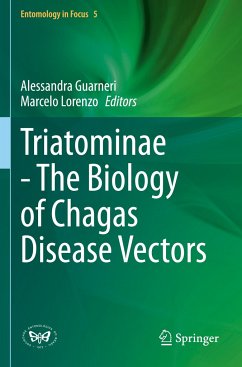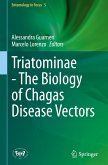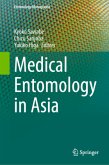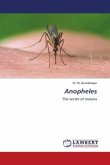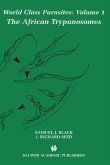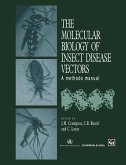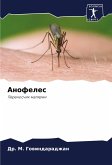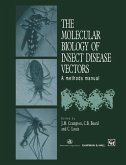Triatominae - The Biology of Chagas Disease Vectors
Herausgegeben:Guarneri, Alessandra; Lorenzo, Marcelo
Triatominae - The Biology of Chagas Disease Vectors
Herausgegeben:Guarneri, Alessandra; Lorenzo, Marcelo
- Broschiertes Buch
- Merkliste
- Auf die Merkliste
- Bewerten Bewerten
- Teilen
- Produkt teilen
- Produkterinnerung
- Produkterinnerung
This book aims to present updated knowledge on various aspects of the natural history, biology, and impact of triatomines to all interested readers. Each chapter will be written by authorities in the respective field, covering topics such as behavior, neurophysiology, immunology, ecology, and evolution. The contents will consider scientific, as well as innovative perspectives, on the problems related to the role of triatomine bugs as parasite vectors affecting millions in the Latin American region.
Andere Kunden interessierten sich auch für
![Triatominae - The Biology of Chagas Disease Vectors Triatominae - The Biology of Chagas Disease Vectors]() Triatominae - The Biology of Chagas Disease Vectors177,99 €
Triatominae - The Biology of Chagas Disease Vectors177,99 €![Medical Entomology in Asia Medical Entomology in Asia]() Medical Entomology in Asia123,99 €
Medical Entomology in Asia123,99 €![Anopheles Anopheles]() Dr. M. GovindarajanAnopheles54,99 €
Dr. M. GovindarajanAnopheles54,99 €![The African Trypanosomes The African Trypanosomes]() Samuel J. Black / J. Richard Seed (eds.)The African Trypanosomes121,99 €
Samuel J. Black / J. Richard Seed (eds.)The African Trypanosomes121,99 €![The Molecular Biology of Insect Disease Vectors The Molecular Biology of Insect Disease Vectors]() CramptonThe Molecular Biology of Insect Disease Vectors161,99 €
CramptonThe Molecular Biology of Insect Disease Vectors161,99 €![Anofeles Anofeles]() Dr. M. GowindaradzhanAnofeles56,99 €
Dr. M. GowindaradzhanAnofeles56,99 €![The Molecular Biology of Insect Disease Vectors The Molecular Biology of Insect Disease Vectors]() The Molecular Biology of Insect Disease Vectors155,99 €
The Molecular Biology of Insect Disease Vectors155,99 €-
-
-
This book aims to present updated knowledge on various aspects of the natural history, biology, and impact of triatomines to all interested readers. Each chapter will be written by authorities in the respective field, covering topics such as behavior, neurophysiology, immunology, ecology, and evolution. The contents will consider scientific, as well as innovative perspectives, on the problems related to the role of triatomine bugs as parasite vectors affecting millions in the Latin American region.
Produktdetails
- Produktdetails
- Entomology in Focus 5
- Verlag: Springer / Springer International Publishing / Springer, Berlin
- Artikelnr. des Verlages: 978-3-030-64550-2
- 1st edition 2021
- Seitenzahl: 652
- Erscheinungstermin: 8. Juli 2022
- Englisch
- Abmessung: 235mm x 155mm x 35mm
- Gewicht: 972g
- ISBN-13: 9783030645502
- ISBN-10: 3030645509
- Artikelnr.: 64174395
- Herstellerkennzeichnung Die Herstellerinformationen sind derzeit nicht verfügbar.
- Entomology in Focus 5
- Verlag: Springer / Springer International Publishing / Springer, Berlin
- Artikelnr. des Verlages: 978-3-030-64550-2
- 1st edition 2021
- Seitenzahl: 652
- Erscheinungstermin: 8. Juli 2022
- Englisch
- Abmessung: 235mm x 155mm x 35mm
- Gewicht: 972g
- ISBN-13: 9783030645502
- ISBN-10: 3030645509
- Artikelnr.: 64174395
- Herstellerkennzeichnung Die Herstellerinformationen sind derzeit nicht verfügbar.
Alessandra Guarneri, Ph.D., is a biologist and specialist in Medical Entomology. She is a researcher in the Vector Behavior and Pathogen Interaction Group at Oswaldo Cruz Foundation in Belo Horizonte, Brazil. Her research team is devoted to the study the behavior of triatomines and the interaction between these bugs and their natural parasites. Her work includes studies about parasite development and virulence, behavioral alterations in infected insects, as well as the molecular bases of the trypanosome-triatomine interaction. Marcelo G Lorenzo, Ph.D., is a biologist devoted to the study of insect physiology with an emphasis on behavioral physiology. He is a senior researcher in the Vector Behavior and Pathogen Interaction Group at Oswaldo Cruz Foundation in Belo Horizonte, Brazil. There, his group investigates the behavior, pheromones, kairomones, sensory physiology, and functional genomics of triatomines and culicids. The group also focuses on the development of baits and traps for vector control. His work takes advantage of techniques from neurobiology, analytical chemistry, molecular biology, genomics, and behavior.
1.Origin and evolution of Triatominae.- 2. Taxonomy.- 3. Speciation Processes in Triatominae.- 4. Chromosome structure and evolution of Triatominae: A review.- 5. Embryonic development of the kissing bug Rhodnius prolixus.- 6. Anatomy of the nervous system of triatomines.- 7. Biogenic monoamines in the control of triatomine physiology with emphasis on Rhodnius prolixus.- 8. Structure and physiology of the neuropeptidergic system of triatomines.- 9. Sensory biology of triatomines.- 10. The behaviour of kissing-bugs.- 11. Features of interaction between triatomines and vertebrates based on bug feeding parameters.- 12. Blood Digestion in Triatomine Insects.- 13. The physiology of sperm transfer and egg production in vectors of Chagas disease with particular reference to Rhodnius prolixus.- 14. The Immune System of Triatomines.- 15. Interaction of triatomines with their bacterial microbiota and trypanosomes.- 16. The ecology and natural history of wild Triatominae in the Americas.- 17. Eco-epidemiology of vector-borne transmission of Trypanosoma cruzi in domestic habitats.- 18. Chagas Disease Vector Control.- 19. Insecticide resistance in triatomines.- 20. Perspectives in triatomine biology studies: "Omics"- based approaches.
1.Origin and evolution of Triatominae.- 2. Taxonomy.- 3. Speciation Processes in Triatominae.- 4. Chromosome structure and evolution of Triatominae: A review.- 5. Embryonic development of the kissing bug Rhodnius prolixus.- 6. Anatomy of the nervous system of triatomines.- 7. Biogenic monoamines in the control of triatomine physiology with emphasis on Rhodnius prolixus.- 8. Structure and physiology of the neuropeptidergic system of triatomines.- 9. Sensory biology of triatomines.- 10. The behaviour of kissing-bugs.- 11. Features of interaction between triatomines and vertebrates based on bug feeding parameters.- 12. Blood Digestion in Triatomine Insects.- 13. The physiology of sperm transfer and egg production in vectors of Chagas disease with particular reference to Rhodnius prolixus.- 14. The Immune System of Triatomines.- 15. Interaction of triatomines with their bacterial microbiota and trypanosomes.- 16. The ecology and natural history of wild Triatominae in the Americas.- 17. Eco-epidemiology of vector-borne transmission of Trypanosoma cruzi in domestic habitats.- 18. Chagas Disease Vector Control.- 19. Insecticide resistance in triatomines.- 20. Perspectives in triatomine biology studies: "Omics"- based approaches.

